Course
Amazon Rekognition is an AI-powered service from Amazon Web Services (AWS) that helps businesses analyze images and videos easily. Whether you need to detect objects, recognize faces, or moderate content, Rekognition makes it possible without requiring deep expertise in machine learning.
This tutorial will walk you through what Amazon Rekognition is, its key features, how it works, and how you can start using it. We’ll also discuss its benefits, pricing, and some of the concerns surrounding its use.
What Is Amazon Rekognition?
Simply put, Amazon Rekognition is a cloud-based service from Amazon Web Services (AWS) that uses deep learning to analyze images and videos. It helps in automatically identifying objects, scenes, faces, text, and even unsafe content—all without requiring deep machine learning knowledge.
This fully managed, deep-learning-based, image-recognition service was designed from the get-go to run at scale. What makes Rekognition stand out is its pre-trained models, which are ready to use right out of the box. But if you have specific needs, you can also train custom models to recognize unique objects or patterns.
The three core components of any machine or deep learning application are training, models, and inference.
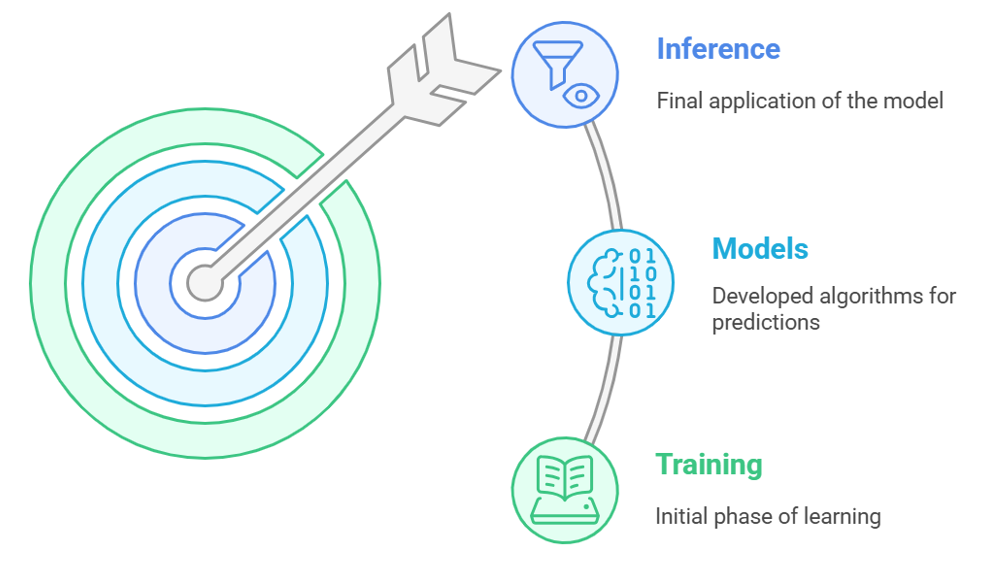
Core Components of an ML - Deep Learning Application. Source: Napkin AI
Out of these three components, the great advantage is that the training has already been done for you with Rekognition APIs. This training has created models which are being used inside the service. You just need to access these APIs to create inferences for your applications.
What's more, this simple API-driven approach means developers—regardless of ML expertise—can swiftly add powerful AI capabilities to their products.
Key Features of Amazon Rekognition
Let's explore some of Rekognition's most impactful features, illustrated through real-world examples.
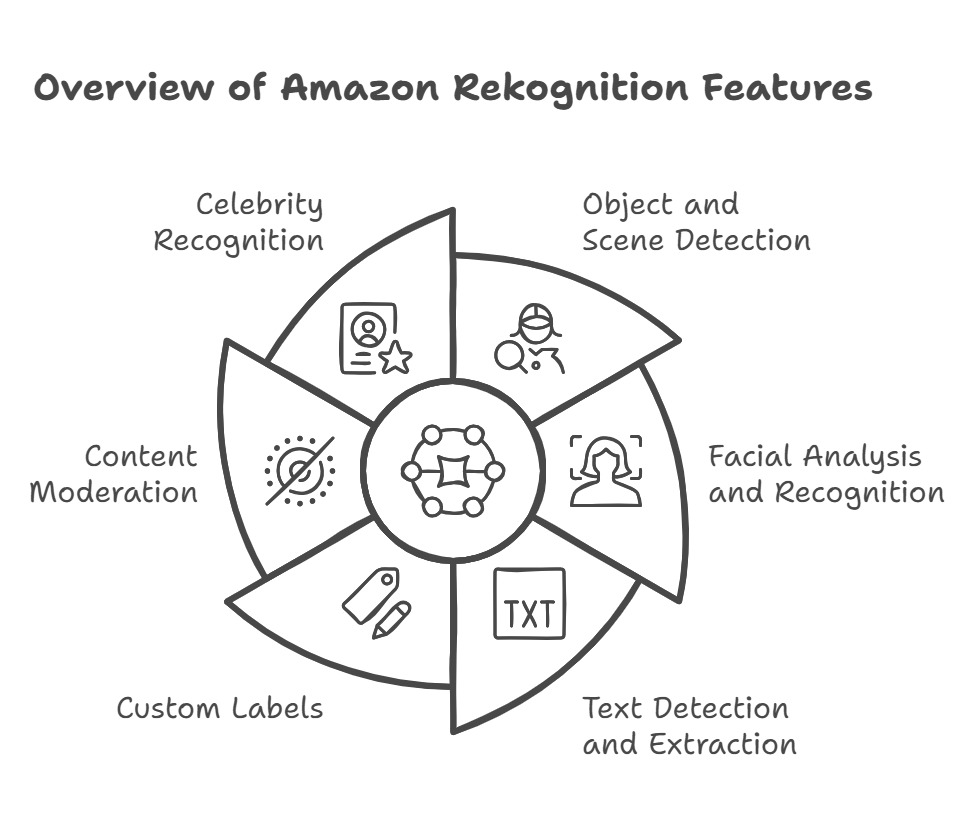
Overview of Amazon Rekognition Features. Source: Napkin AI
Object and scene detection
Thousands of objects, scenes, actions in pictures and videos can be precisely identified and labeled by Amazon Rekognition. For example, it can aid in automating inventory management by identifying products on store shelves. Likewise, it can recognize cars and pedestrians in traffic surveillance tasks.
Pinterest uses Rekognition to label the content uploaded by users and identify objects, scenes, and activities. This helps tag images with relevant keywords, improving the platform’s ability to recommend visually similar content.
Facial analysis and recognition
Rekognition's sophisticated facial analysis and recognition capabilities enable it to identify characteristics like age range, gender, and emotions. Additionally, it provides facial recognition for identification verification—think building entrance systems or airport security gates. Rekognition is used by businesses to safely confirm user identities in banking apps or attendance systems.
Using Amazon Rekognition, PBS created an enterprise knowledge graph to gather content metadata at the segment, clip, or even the frame level, and easily attribute facial, object, and mood recognition information to over 60,000 titles within the PBS digital library.
Text detection and extraction
Have you ever wondered how social media sites recognize memes or images with text overlays? Rekognition efficiently detects and recognizes text in photographs or video frames, even when the text is not entirely clear or aligned. This can be used in enhanced automated document processing by businesses or even for performing sentiment analysis based on visual data.
Custom labels
One clear differentiator of Amazon Rekognition is Custom Labels, which enables companies to train Rekognition on their own data. If you’re a marketer and want to see your brand’s logo being uploaded on social media, Rekognition can identify your logo across millions of images without the need for you to spend hundreds of hours manually reviewing them—generating actionable marketing insights.
San Diego Gas & Electric (SDG&E) uses Rekognition’s custom labels to automatically identify asset damage on drone imagery and vegetation risks on satellite imagery.
Content moderation
With its content moderation feature, social media companies and video-streaming platforms use Rekognition to automatically filter out inappropriate contents such as sexually explicit material and graphic violence from user uploads. It ensures that handling massive amounts of user-generated content is very simple and absolutely reliable.
Celebrity recognition
Amazon Rekognition's celebrity recognition feature is used extensively by media companies covering entertainment events. The fast identification of celebrities allows content providers to auto-tag photos or videos from red-carpet events or news stories, providing a dramatic workflow improvement.
How Amazon Rekognition Works
Amazon Rekognition uses advanced deep-learning models hosted on a scalable AWS cloud computing infrastructure. Here is the simplified workflow:
- Input Data: You provide images or video through the Rekognition API.
- AI Processing: Rekognition's deep-learning models analyze the data, detecting faces, objects, text, or content type.
- Results: Results are returned in quick time via API calls in JSON format, ready to be integrated into your apps or databases.
This service can work together with other AWS solutions such as AWS Lambda and Amazon Kinesis to allow for real-time analysis scenarios, such as live video monitoring for security.
High-level architecture
- Images or video streams uploaded to Amazon S3.
- AWS Rekognition API calls trigger AI inference.
- Results are sent back through the API to your application or services.
Image Pipeline
The high-level pipeline is outlined below:
- A message is sent to an Amazon SQS queue, initiating the image processing pipeline.
- This triggers a Lambda function, which runs synchronously.
- The Lambda function calls Amazon Rekognition to analyze the image.
- The analysis results are stored in DynamoDB, S3, or Elasticsearch, depending on the use case.
- The throughput of the pipeline is controlled by adjusting the batch size and Lambda concurrency, ensuring efficient processing.
Video Pipeline
The high-level pipeline is outlined below:
- The video processing pipeline sends messages to an Amazon SQS queue, which initiates video analysis.
- A job scheduler Lambda function runs at regular intervals, submitting video processing requests to Amazon Rekognition until the maximum number of concurrent jobs is reached.
- When a video analysis job is completed, Amazon Rekognition sends a notification via Amazon SNS, triggering the submission of the next batch of jobs.
- The results from the analysis are stored in the appropriate datastores for further use.
- The pipeline automatically adjusts its processing speed based on AWS account limits, ensuring optimal performance.
This reference architecture can give you a more technical deep-dive if needed.
How to Use Amazon Rekognition
Here’s how easily businesses can integrate Amazon Rekognition into their workflow:
Amazon Rekognition workflow
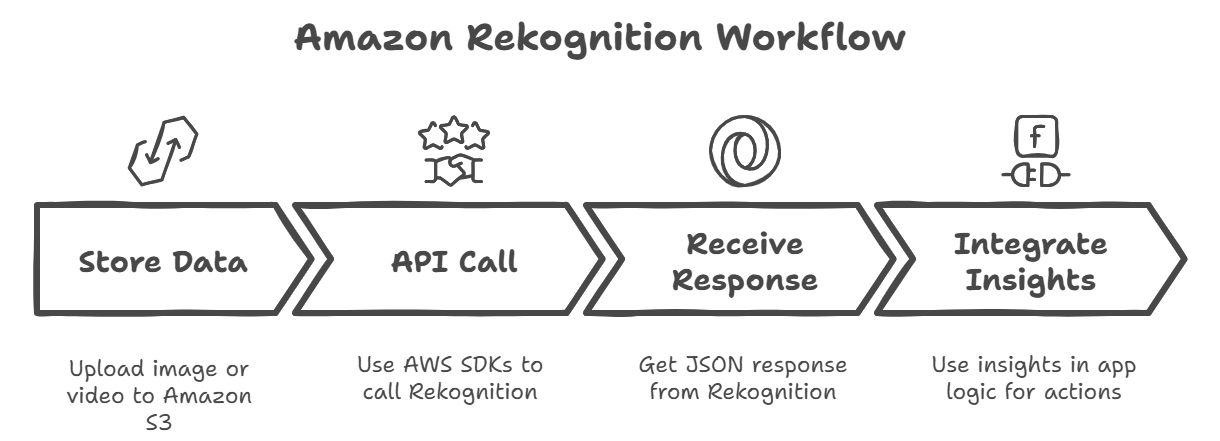
Amazon Rekognition Workflow. Source: Image by Napkin AI
- Step 1: Store your image/video data in Amazon S3.
- Step 2: Make an API call to Rekognition using AWS SDKs (available for Python, Java, Node.js, etc.).
- Step 3: Receive and process Rekognition’s JSON response with insights.
- Step 4: Integrate these insights into your app logic, triggering actions like alerts or content filtering.
Getting started with Amazon Rekognition
The main steps to get started with Rekognition are outlined below.
- Sign Up: Create your AWS account at aws.amazon.com.
- Setup via AWS Console: Access Rekognition through AWS Management Console. You can do this by typing Rekognition in the search bar and selecting rekognition to open the service console.
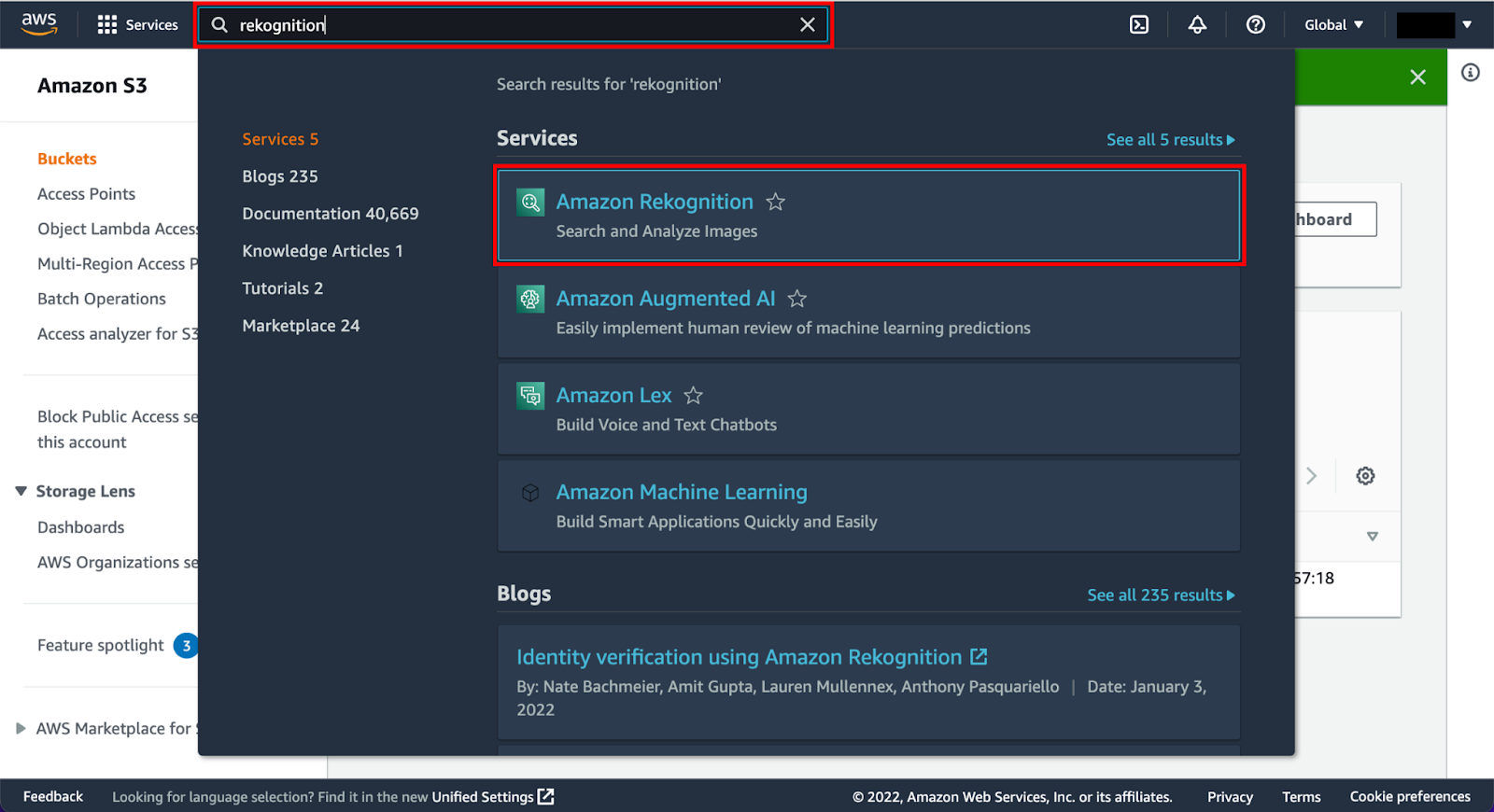
Setting up Amazon Rekognition via AWS Console. Source: AWS
- AWS CLI & SDK integration: Install AWS CLI or preferred SDK for programmatic access.
- Implement a sample analysis: Try running a simple image analysis to get comfortable. For example, you can select Facial analysis in the panel navigation on the left as shown below. This feature allows you to analyze faces in an image and receive a JSON response.
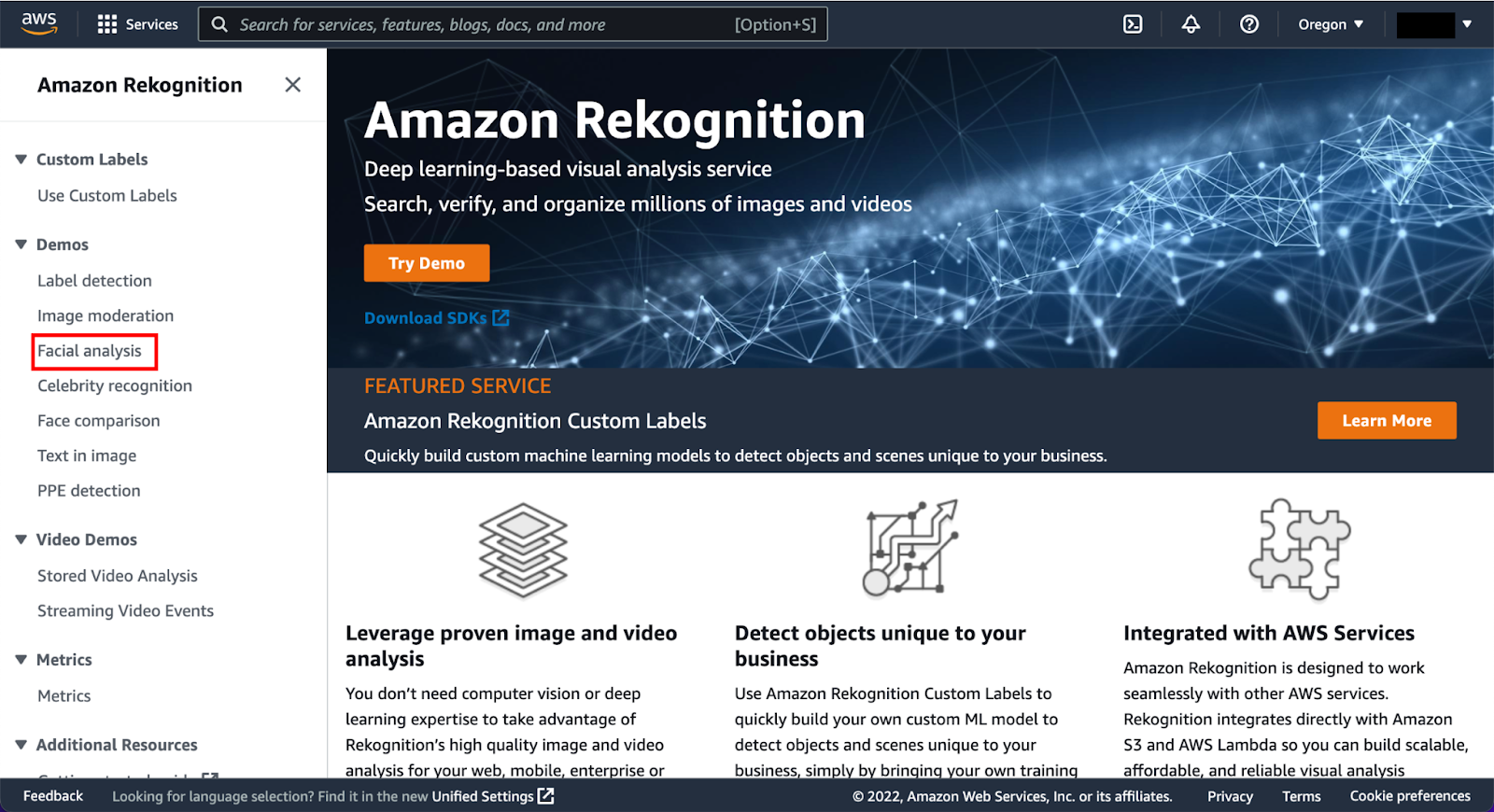
Select the relevant service. Source of Image: AWS
As you have seen, it's surprisingly straightforward!
Benefits of Amazon Rekognition
Some of the reasons why businesses like Rekognition include:
Scalability & performance
Since Rekognition runs on AWS infrastructure, it can scale automatically, handling millions of images and videos without lag. Businesses don’t have to worry about performance drops, no matter how big their workload gets. It's also possible to augment human review tasks with AI.
Cost efficiency
With its pay-as-you-go pricing model, companies only pay for what they use, making it a budget-friendly solution without heavy upfront investment.
Ease of integration
The user-friendly APIs make it simple to implement, even for teams with little to no machine learning expertise. No need to build complex models from scratch—just plug it in and start analyzing images or videos.
Accuracy & reliability
Amazon continuously trains and improves its AI models, meaning better accuracy and less manual effort for businesses. This helps reduce human errors in tasks like identity verification, object detection, and content moderation.
Concerns and Controversies Around Amazon Rekognition
Like any powerful technology, Rekognition has sparked a few valid concerns:
Privacy and surveillance concerns
The use of Rekognition in law enforcement and surveillance has sparked heated debates. Critics argue that AI-powered facial recognition could be misused for mass surveillance, potentially infringing on privacy rights and civil liberties. Amazon has come under fire for selling this technology to government agencies, with concerns about how it’s being used and whether it lacks proper oversight.
Bias in facial recognition
AI bias is a real issue, and studies, including those from MIT, have shown that facial recognition systems can struggle with accuracy, especially when identifying individuals from different racial or gender groups. Misidentifications can have serious consequences, particularly in law enforcement, where false matches could lead to wrongful arrests. This controversy underscores the urgent need to improve AI fairness and ensure that facial recognition models work equally well across diverse populations.
Ethical use and regulation
Amid growing criticism, Amazon decided to put a temporary halt on selling Rekognition to law enforcement agencies, acknowledging the ethical concerns surrounding its use. The debate over AI ethics continues, with organizations like the ACLU pushing for stricter oversight and accountability.
Amazon Rekognition Pricing
Amazon Rekognition follows a pay-as-you-go pricing model, meaning you only pay for what you use. The pricing is based on the type of analysis you perform, and there are no upfront investments. Let’s understand it better:
Image pricing
Rekognition Image allows you to analyze images using deep learning technology. Pricing is divided into two parts:
- Image analysis: You are charged per image analyzed. If you run multiple analyses on the same image, you’ll be charged for each request separately. So, to take an example, If you analyze 2.5 million images for label detection, the cost structure looks like this:
First 1 million images: $0.0010 per image, cost will be $1,000.
Next 1.5 million images: $0.0008 per image, cost will be $1,200
Total cost: $2,200
- Face metadata storage: If you use face comparison or face search, Rekognition stores face metadata, and you’ll be billed a small monthly fee for this storage. The charges are $0.00001/face metadata per month, where storage charges are applied monthly and are prorated for partial months.
Video pricing
If you’re analyzing videos instead of images, you’ll be charged per minute of processed footage.
- Label detection (detecting objects, scenes, and activities): Starts at $0.10 per minute
- Face search (matching faces to a database): Starts at $0.10 per minute
So, processing 1,000 minutes of video for label detection would cost $100 at $0.10 per minute.
Custom labels pricing
Rekognition allows businesses to train it to recognize specific objects unique to their needs. This feature has two costs:
- Training a Model: $1.00 per hour
- Running Predictions (Inference): $4.00 per 1,000 images
It's noteworthy that the Training and Inference usage is billed on minute increments, with a minimum of 1 minute.
Detailed pricing on various other services is continuously updated and can be seen on the Amazon Rekognition Pricing page.
Conclusion
Amazon Rekognition is a powerful AWS product for image and video analysis, offering features such as facial recognition, object detection, text extraction, and content moderation. Its scalability, ease of integration, and cost-efficiency make it valuable for businesses across industries.
If you're exploring new ways to make use of advanced computer vision for your business, Amazon Rekognition is undoubtedly a valuable and accessible starting point.
And if you want to explore and learn more on related AWS services and products, we have great resources might help:
- AWS Concepts Course: Discover the world of Amazon Web Services (AWS) and understand why it's at the forefront of cloud computing.
- AWS Cloud Technology and Services Concepts Course: Master AWS cloud technology with hands-on learning and practical applications in the AWS ecosystem.
- AWS Cloud Practitioner Certification (CLF-C02): Demonstrate your foundational knowledge of AWS cloud services, and access everything you need to prepare for the AWS Cloud Practitioner Certification.
- AI Ethics: Why Getting It Right Matters (Podcast & Blog)
- AI Regulation: Understanding Global Policies Blog
- AI Ethics Course: Explore AI ethics focusing on principles, fairness, bias reduction, and trust in AI design.

Seasoned professional in data science, artificial intelligence, analytics, and data strategy.
FAQs
What is Amazon Rekognition?
Amazon Rekognition is an AWS service that analyzes images and videos to detect objects, faces, text, and more using AI.
Do I need machine learning experience to use Amazon Rekognition?
No, Rekognition is designed for easy integration with APIs, so you don’t need any ML expertise to use it.
How much does Amazon Rekognition cost?
Pricing is based on usage. You pay per image or video minute analyzed.
How do I get started with Amazon Rekognition?
Sign up for AWS, enable Rekognition, and start analyzing images or videos.
What are the concerns around Amazon Rekognition?
Privacy, bias, and potential misuse in surveillance are key concerns. Amazon has placed limits on law enforcement use and continues improving fairness.
